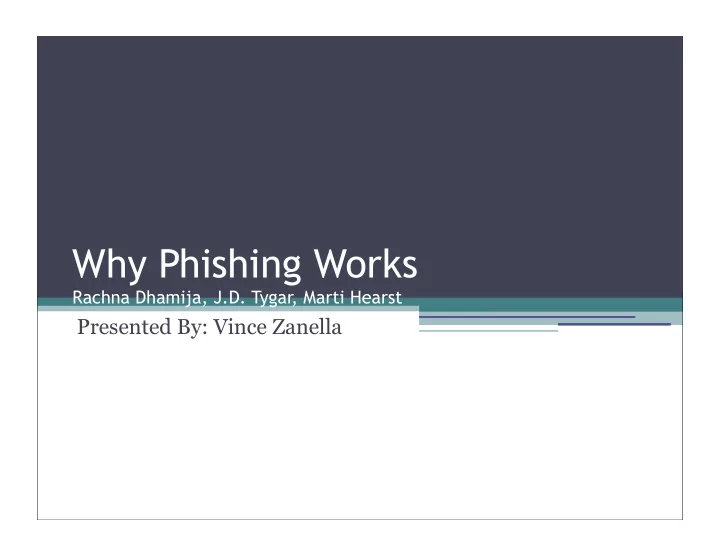

Why Phishing Works Rachna Dhamija, J.D. Tygar, Marti Hearst Presented By: Vince Zanella
Motivation • To shield users from fraudulent websites, website designers must know which attack strategies work and why • Hypotheses exist, but no empirical evidence • Quick numbers: Top phishing sites have tricked upwards of 5% of their recipients into providing them with sensitive information • Classic Question: What makes a website credible?
This Paper: What Makes a FRAUDULANT Website Credible? • Very interesting space to explore for user- interface designers • Both phishers and anti-phishers are doing battle in this same space • But wait, there are already several security measures built into the browser to defeat phishers!
The Empirical Study: A Usability Test • 22 Participants were showed 20 different websites • Good phishing sites: 90% fooled • Existing anti-fishing cues: ineffective • Average rate of mistakes: 40% • Popups warning of fraudulent certificates: ineffective • Participants vulnerable across all backgrounds
Exploit Strategies • Lack of Knowledge ▫ Lack of computer system knowledge ▫ Lack of security indicator knowledge • Visual Deception ▫ Visually deceptive text ▫ Images masking underlying text ▫ Images mimicking windows ▫ Windows masking underlying windows ▫ Deceptive look and feel • Bounded Attention ▫ Lack of attention to security indicators ▫ Lack of attention to absence of security indicators
The Test: Details • Users were presented with financial and e- commerce websites; some were real, some were spoofs • Participants task was to identify legitimate and fraudulant websites and give reasoning • Participants were primed to look for tipoffs • Note: Study did not look at email lures; instead focused on website security
More Details • 200 real phishing sites surveyed – a sample of 9 chosen that were representative of the different attack vectors; 3 additional spoof sites created; 7 legitimate sites chosen • Participants each saw all websites, but in randomized order • Used Mozilla Firefox 1.0.1 running on Mac OS X • 20 th website in the group was the same for all participants -> required users to accept a self- signed SSL certificate
Demographics • 45% Male • Age: 18 – 56, Mean: 29.9, StdDev: 10.8 • Half university staff, half university students • 14% in technical field • Primary Browser: 50% IE, 32% FF, 9% Mozilla Unknown, 5% Safari • Computer Usage Hours per Week: 10 – 135, Mean: 37.8, StdDev: 28.5
Results • Score: raw number of correctly identified sites: 6 – 18, Mean: 11.6, StdDev: 3.2 • No statistical correlation with a single demographic
Strategies Employed • Type I (23%): ▫ Used only content of a webpage to authenticate ▫ Confirmed they never looked at the address bar, and didn’t actually know what its purpose was ▫ Scored the worst (6,7,7,9,9) • Type II (36%): ▫ Used content and domain name only ▫ Still did not look for any SSL indicators, but were aware of address bar changing ▫ Distinguished IP addresses from domain names in address bar • Type III (9%): ▫ Used content and address bar, plus https ▫ Still didn’t look for other SSL indicators, like the padlock ▫ Some incorrectly identified site icons (favicons) as security features that cannot be duplicated • Type IV (23%): ▫ All of the above, plus the padlock ▫ Still, some users gave high credence to a padlock within a page’s content • Type V (9%): ▫ Everything above, plus certificates ▫ Occasionally check certificates when presented with a warning
The Toughest Phishing Site to Detect • Spoof of Bank of the West’s site • Hosted at www.bankofthevvest.com, instead of the legitimate www.bankofthewest.com • Everything else copied nearly identically • Users were very trusting because it didn’t ask for much personal info, linked to anti-phishing how-to, linked to the real BOW’s Verisign certificate popup, linked to the real BOW’s Chinese language version of the page • Essentially, nobody thought a spoof site would go to this level of detail • Fooled the participant with the highest level of security expertise • Only two participants correctly identified it, one noticing the double “v”, the other noticing a stale date
Results Compared to Hypotheses • Lack of computer system knowledge led to vulnerability • Experienced users tripped up with visual deception • New : Lack of knowledge of web fraud • New : Erroneous security knowledge
Conclusions • Even in best scenario, with users expecting spoofs to be present, good fishing site can subvert 90% of users • Trustworthiness indicators misunderstood and misused • A new approach for website security is needed – cryptography cannot be the sole security measure • Really need to think of new ways to help novices more easily identify fraudulent sites, both through improved measures and better training
Questions/Concerns? • Mine: Why not a larger sample size? • Yours…???
Recommend
More recommend